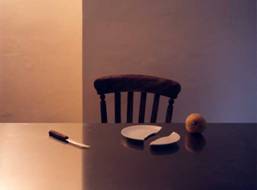Diderot
dal 13/1/2005 al 27/2/2005
Segnalato da
13/1/2005
Diderot
Danielle Arnaud Contemporary Art, London
David Bate, Sharon Kivland, Jeannie Lucas, Patricia & Marie-France Martin. An interpretation of experience based on Denis Diderot (1713-1784). The aim is to open up a dialogue with the legacy of his work for us today. Each artist takes up different aspects of Diderot's work and takes them down their own path.

David Bate Sharon Kivland Jeannie Lucas Patricia & Marie-France Martin
In this exhibition the artists propose an interpretation of experience based on Denis Diderot (1713-1784). The aim is to open up a dialogue with the legacy of his work for us today. The artworks in the exhibition elude simple categorization, they do not illustrate Diderot (his oeuvre, his ideas or his texts), rather the artworks are partial and playful, neither totally sincere nor quite parody. Each artist takes up different aspects of Diderot’s work and takes them down their own path: DIDEROT becomes a means to speak to our time.
It may seem unusual for artists to present work in an exhibition under the name of an art critic. But Denis Diderot was no ordinary critic. Diderot is a key French Enlightenment figure, famous as an important theatre critic, novelist and polymath thinker who used the Annual Painting Salons to construct his Philosophy on art and culture. As the first modern art critic, his ideas had a huge impact in the sphere of French culture. His ideas of tableau and mise-en-scène as a theory of 'staging' (relevant now not only for painting and theatre but also cinema, photography and video performances) have endured. The notion of sensibility that he developed (introduced the viewer’s body into the meaning of a picture), have been taken up by many thinkers since and form the basis of much modern thinking about experience in art.
Yet the exhibition is not a homage to Diderot. Although Diderot influenced the visual arts of his day, the artists here intervene in the thinking of Diderot, in particular, his preoccupation with the sentimental genres that were so typical of the popular middlebrow dramas of his day. All too ready to shed tears, the ‘sentimental’ calls upon the viewer to take the image further, to take the image into their own imaginary where dreams, whether already shattered or ideal, follow the route of a wishing.
David Bate responds to Diderot’s concept of tableau and his praise of the then highly popular artist Jean-Baptiste Greuze to invoke questions about memory. Photographing domestic objects accidentally broken by him, Bate elevates these things from the humble still life to extravagant dramas of lost memories and enjoyment of the emotions involved in a broken object.
Sharon Kivland takes up the themes of Diderot’s novel of 1748, Les Bijoux indiscrets, written as he claimed, to amuse himself and please his readers. It is the story of a magic ring, given by a genie to his master a Sultan who, when the ring is turned towards a woman, hears a secret voice: her ‘jewel’ begins to speak from under her skirts. In Kivland’s Indiscrets a vulgar French slang word for women’s genitals casts its shadow on the image of an eighteenth-century chair.
Jeannie Lucas has painted seven almost identical portraits of mademoiselle Lavergne, after the work of Jean-Etienne Liotard, a contemporary of Diderot. Depicted against different background colours and décor, the figure in the painting subtly depicts Diderot’s ‘paradox of the comedian’, that an actor should control his own emotions in order to display the feelings of the character.
Patricia & Marie-France Martin’s new video work takes as its starting point fragments of text from Diderot’s novel, Jacques the Fatalist. With affinities to Samuel Beckett’s famous play Waiting for Godot, the two artists invoke similar questions about destiny and ties between people. In the video, two women are driving somewhere and nowhere.
Private view: Friday 14 January 6 – 9 pm
Image: David Bate Bungled Memory 2004 c-type print
For further information and slides/digital images contact Danielle Arnaud on 020 7735 8292
Danielle Arnaud contemporary art
123 Kennington Road
London SE11 6SF UK



